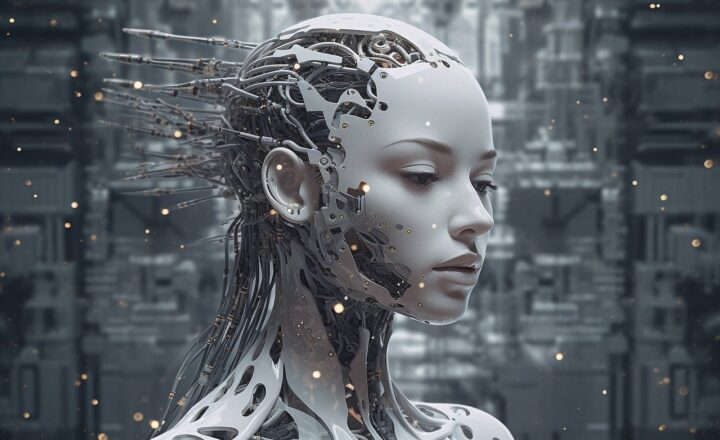
Artificial Intelligence (AI) and Machine Learning (ML) have transformed the technological landscape, influencing everything from business decisions to personal convenience. These technologies have become buzzwords across industries, but what do they really mean? In this article, we will unpack the basics of AI and ML, explore their differences, delve into how they work, and discuss their potential applications.
1. What is Artificial Intelligence?
Artificial Intelligence refers to the simulation of human intelligence in machines that are programmed to think and learn like humans. AI systems can perform tasks such as reasoning, problem-solving, understanding language, and recognizing patterns.
There are two primary types of AI:
- Narrow AI (Weak AI): This type of AI is designed to perform a specific task, such as voice assistants (like Siri or Alexa) or recommendation engines (like those used by Netflix and Amazon).
- General AI (Strong AI): This form of AI possesses the ability to understand, learn, and apply knowledge in a way that is indistinguishable from human intelligence. Currently, General AI remains theoretical and is a subject of ongoing research.
AI plays a crucial role in various domains, including healthcare, finance, and transportation, allowing for improved efficiency, better decision-making, and enhanced experiences.
2. What is Machine Learning?
Machine Learning is a subset of AI that involves the use of algorithms and statistical models to enable computers to improve their performance on a specific task through experience. Essentially, it allows machines to learn from data without being explicitly programmed for each specific task.
Machine learning can be categorized into three main types:
- Supervised Learning: In this approach, the model is trained on a labeled dataset, meaning the input data is paired with the correct output. The model learns to predict outcomes based on this data. Examples include spam detection and image classification.
- Unsupervised Learning: Here, the model works with unlabeled data and identifies patterns and relationships within the data without explicit instructions. Clustering and association algorithms are typical examples, used in market segmentation and recommendation systems.
- Reinforcement Learning: This type involves training an agent to make decisions by rewarding it for good decisions and punishing it for bad ones. It’s commonly used in robotics and game playing (like AlphaGo).
Machine learning is crucial for applications requiring predictive analytics, automation, and data mining.
3. Key Differences Between AI and Machine Learning
While AI and ML are often used interchangeably, they are not the same:
- Scope: AI is an umbrella term that encompasses any technique allowing computers to mimic human behavior, while ML is specifically focused on the use of data to train algorithms.
- Functionality: AI can function without machine learning. For instance, rule-based expert systems are a form of AI that does not utilize ML, relying instead on pre-defined rules. Conversely, ML cannot exist without AI as it depends on AI principles to function.
- Learning Approach: AI is more static, relying on explicitly programmed rules, whereas ML is adaptable and can optimize itself based on performance and feedback from new data.
4. How Do AI and Machine Learning Work?
The functioning of AI and ML involves several key components:
- Data Collection: The first step is to gather relevant data, which can come from various sources such as databases, user interactions, and sensors. Quality data is crucial for effective learning and accuracy.
- Data Preparation: The collected data is then cleaned, organized, and transformed into a format suitable for analysis. This step often includes handling missing values, normalizing data, and feature selection.
- Model Selection and Training: Depending on the problem, algorithms are chosen and trained on the prepared data. This adaptability is what makes ML powerful; it learns patterns from data rather than following rigid programming rules.
- Model Evaluation and Tuning: After training, the model is evaluated using a separate validation dataset to measure its performance. Tuning involves optimizing the model’s parameters to enhance accuracy and reduce errors.
- Deployment and Monitoring: Once a model is fine-tuned, it’s deployed for use in real-world applications. Continuous monitoring and updates ensure that the model remains accurate and relevant over time as new data emerges.
The synergy of these components creates a powerful framework capable of learning and making predictions or decisions based on new information.
5. Applications of AI and Machine Learning
AI and ML are revolutionizing countless industries. Here are some notable applications:
- Healthcare: AI algorithms assist in diagnosing diseases by analyzing medical images, helping doctors make more informed decisions. Machine learning models also predict patient outcomes and optimize treatment plans.
- Finance: In the finance sector, AI and ML drive fraud detection systems, algorithmic trading, and personalized banking experiences through data analysis and predictive analytics.
- Transportation: AI is central to the development of autonomous vehicles, utilizing machine learning for navigation, obstacle detection, and route optimization.
- Customer Service: Chatbots and virtual assistants powered by AI and ML enhance customer service experiences, providing instant support and personalizing interactions.
- Marketing: AI algorithms analyze consumer behavior patterns to enhance targeting, optimize advertising campaigns, and recommend products to users based on past purchases.
As technology continues to evolve, the applications of AI and machine learning will only expand, further embedding these technologies into daily life and business.
6. The Future of AI and Machine Learning
AI and machine learning are poised for significant growth in the coming years. Emerging trends include:
- Explainable AI: As AI systems make more critical decisions, transparency in decision-making will become paramount. Showcasing how models derive conclusions will be crucial for trust and accountability.
- Advancements in Natural Language Processing (NLP): NLP technologies are expected to improve vastly, enabling more fluid human-computer interactions and more intuitive communication with devices.
- AI Ethics and Governance: As the capabilities of AI expand, so will the discussions around the ethical implications. Frameworks for responsible AI usage and governance will emerge, ensuring fairness, accountability, and transparency in AI implementations.
- Integration with IoT Devices: The fusion of AI and the Internet of Things (IoT) is anticipated to drive smart environments where devices communicate and learn from each other, enhancing automation and efficiency across industries.
The potential of AI and machine learning is limitless, pushing boundaries in innovation and efficiency.
Conclusion
Understanding the basics of AI and machine learning is crucial for navigating an increasingly digital landscape. These technologies have the power to revolutionize industries, improve decision-making, and enrich our daily lives. As we move forward, the possibilities that AI and ML present will only grow, marking a new era of innovation and advancement.
Engaging with AI and machine learning today not only equips individuals and businesses with a competitive edge but also illuminates pathways for future developments that could redefine our world.







